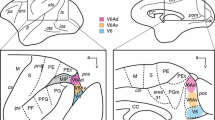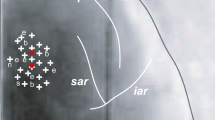Abstract
The motor thalamic areas receiving input from the globus pallidus (VA) and the cerebellar nuclei (VL) appear to have different roles in the generation and guidance of movements. In order to further test these differences, we used electrical stimulation to map the ventro-anterior and ventro-lateral nuclei of the thalamus in three ketamine anaesthetised monkeys. Movements were readily evoked from VL at currents of down to 10 μA. The movements were typically multi-joint, and stimulation could evoke arm and trunk or arm and facial movement at the same current threshold. Evoked arm movements often involved multiple joints, with or without finger movements. Facial movements included the lips, tongue, jaw, eyebrows and, occasionally, the eyes. The thalamic map was topographic, but complex with at least two separate regions related to arm movement. Very few sites within the VA could stimulate movement, even at high currents. We therefore suggest that the cerebellar projections to motor regions of the cortex, which pass through the VL thalamic nuclei, have a different relationship and are closer to movement execution than the projections from basal ganglia via the ventro-anterior nucleus.
Similar content being viewed by others
Author information
Authors and Affiliations
Additional information
Received: 15 July 1997 / Accepted: 3 June 1998
Rights and permissions
About this article
Cite this article
Miall, R., Price, S., Mason, R. et al. Microstimulation of movements from cerebellar-receiving, but not pallidal-receiving areas of the macaque thalamus under ketamine anaesthesia. Exp Brain Res 123, 387–396 (1998). https://doi.org/10.1007/s002210050584
Issue Date:
DOI: https://doi.org/10.1007/s002210050584




